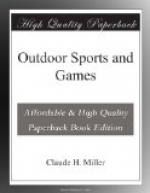[Illustration: A type of camp fire that will burn all night]
There are all sorts of camp fireplaces. The quickest one to build and one of the best as well, is the “hunter’s fire,” All you need is an axe. Take two green logs about six to eight inches thick and five feet long and lay them six inches apart at one end and about fourteen inches at the other. Be sure that the logs are straight. It is a good plan to flatten the surface slightly on one side with the axe to furnish a better resting place for the pots and pans. If the logs roll or seem insecure, make a shallow trench to hold them or wedge them with flat stones. The surest way to hold them in place is to drive stakes at each end. Build your fire between the logs and build up a cob house of firewood. Split wood will burn much more quickly than round sticks. As the blazing embers fall between the logs, keep adding more wood. Do not get the fire outside of the logs. The object is to get a bed of glowing coals between them. When you are ready to begin cooking, take out the smoky, burning pieces and leave a bed of red-hot coals. If you have no axe and can find no logs, a somewhat similar fireplace can be built up of flat stones, but be sure that your stone fireplace will not topple over just at the critical time.
If you only have your jack-knife, the best fire is a “Gypsy Rig”. Cut two crotched sticks, drive them into the ground and lay a crosspiece on them just as you would begin to build the leanto described in the preceding chapter, but of course not so high above the ground. The kettles and pots can be hung from the crossbar by means of pot hooks, which are pieces of wood or wire shaped like a letter “S.” Even straight sticks will do with two nails driven into them. These should be of different lengths to adjust the pots at various heights above the fire, depending on whether you wish to boil something furiously or merely to let it simmer. Do not suspend the kettles by running the bar through them. This is very amateurish. With a gypsy fire, the frying pan, coffee pot and gridiron will have to be set right on the bed of coals.
An arrangement for camp fires that is better and less work than the logs is obtained by using fire irons, which are two flat pieces of iron a yard or so long resting on stones and with the fire built underneath.
The whole object of either logs or irons is to furnish a secure resting place for cooking utensils above the fire.
There are several kinds of ovens used for baking bread and roasting meat in outdoor life. The simplest way is to prop a frying pan up in front of the fire. This is not the best way but you will have to do it if you are travelling light. A reflector, when made of sheet iron or aluminum is the best camp oven. Tin is not so satisfactory because it will not reflect the heat equally. Both the top and bottom of the reflector oven are on a slope and midway between is a steel baking pan held in place by grooves. This oven can be moved about at will to regulate the amount of heat and furthermore it can be used in front of a blazing fire without waiting for a bed of coals. Such a rig can easily be made by any tinsmith. A very convenient folding reflector oven can be bought in aluminum for three or four dollars. When not used for baking, it makes an excellent dishpan.




